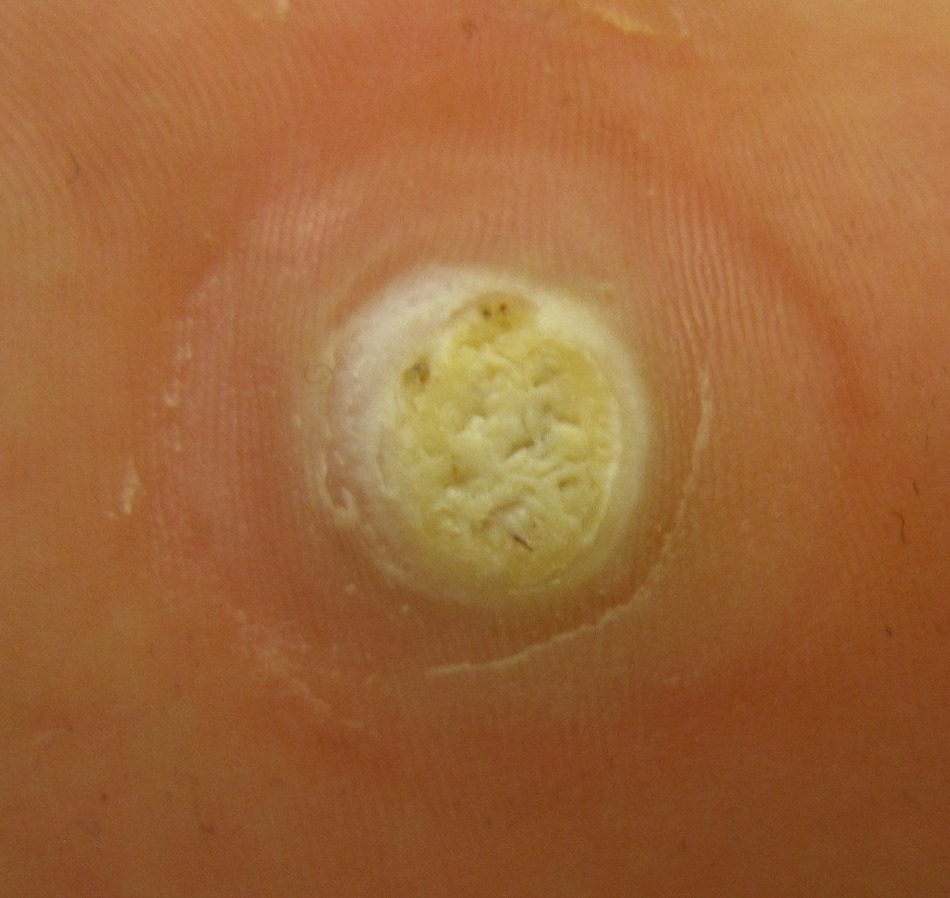
Image: "Large plantar wart" by James Heilman, MD is licensed under CC BY-SA 3.0. Link to the source.
Verrucae (Warts)
Introduction | Aetiology and Pathophysiology | Clinical Presentation | Diagnosis | Management and Treatment | When to Refer | References
Introduction
Verrucae, commonly known as warts, are benign skin growths caused by the human papillomavirus (HPV). They can occur on various parts of the body but are most commonly found on the hands, feet (where they are called plantar warts), and face. While verrucae are generally harmless, they can be painful, particularly when located on weight-bearing areas like the soles of the feet. Warts are highly contagious and can spread through direct contact with the wart or contaminated surfaces.
Aetiology and Pathophysiology
Verrucae are caused by infection with the human papillomavirus (HPV), a double-stranded DNA virus. More than 100 types of HPV exist, but a few types are specifically associated with verrucae:
- HPV Types: HPV types 1, 2, 4, 27, and 57 are commonly associated with verrucae on the hands and feet. HPV infects the keratinocytes of the skin, leading to hyperproliferation and the characteristic wart appearance.
- Transmission: The virus is transmitted through direct contact with an infected individual or indirectly through fomites, such as towels, shoes, or floors. The risk of transmission is higher in moist environments, such as swimming pools and communal showers.
- Risk Factors: Risk factors for developing verrucae include immunosuppression, breaks in the skin (e.g., cuts, abrasions), and walking barefoot in public places. Children and young adults are more commonly affected.
Clinical Presentation
Verrucae present as well-defined growths on the skin with characteristic features depending on their location:
- Common Warts (Verruca Vulgaris): These are firm, raised lesions with a rough, papillomatous surface. They are typically found on the hands, fingers, and knees and may have black dots (thrombosed capillaries) on the surface.
- Plantar Warts (Verruca Plantaris): Found on the soles of the feet, these warts are often flattened due to pressure from walking. They can be painful, particularly when located over weight-bearing areas. They may appear as a single lesion or as a cluster (mosaic warts).
- Flat Warts (Verruca Plana): These are small, flat-topped, smooth papules that commonly occur on the face, neck, hands, and wrists. They are often skin-coloured or slightly darker.
- Filiform Warts: These are long, narrow, and finger-like warts, often found on the face, particularly around the lips and eyelids.
Diagnosis
The diagnosis of verrucae is typically clinical, based on the characteristic appearance of the lesions:
- Clinical Examination: The diagnosis is usually straightforward, with the rough surface, well-defined margins, and location of the lesions being key identifying features.
- Dermatoscopy: Dermatoscopy can be used to enhance the diagnosis, revealing tiny black dots representing thrombosed capillaries within the wart.
- Histopathology: A biopsy is rarely needed but may be performed if the diagnosis is uncertain, especially to differentiate verrucae from other skin lesions like squamous cell carcinoma.
Management and Treatment
While verrucae often resolve spontaneously within a few months to years, treatment may be sought for symptomatic relief or cosmetic reasons. Various treatment options are available:
1. Topical Treatments
- Salicylic Acid: This is the most commonly used topical treatment for verrucae. It works by softening the keratin and gradually removing the wart. Patients should be instructed to apply the solution or plaster daily after soaking the wart in warm water and gently filing down the surface.
2. Cryotherapy
- Liquid Nitrogen: Cryotherapy involves freezing the wart with liquid nitrogen, causing cellular damage and destruction of the wart tissue. Multiple treatments, spaced 2-3 weeks apart, may be required.
- Pain and Blistering: Cryotherapy can be painful and may cause blistering. Patients should be advised of these potential side effects.
3. Other Treatments
- Electrosurgery and Curettage: In some cases, the wart may be removed using electrosurgery (burning) followed by curettage (scraping). This procedure is typically done under local anaesthesia.
- Laser Therapy: Pulsed dye laser treatment can be used to target the blood vessels supplying the wart, leading to its destruction.
- Immunotherapy: Topical immunotherapeutic agents like imiquimod or intralesional immunotherapy can be used to stimulate the body’s immune response against the wart. These treatments are more commonly used for recalcitrant warts.
4. Prevention
- Avoiding Direct Contact: Patients should be advised to avoid direct contact with warts, whether their own or others, to reduce the risk of spreading the virus.
- Footwear in Public Areas: Wearing flip-flops or shoes in communal showers, pools, and locker rooms can help prevent HPV infection.
- Good Hygiene Practices: Encourage regular handwashing and not sharing personal items like towels or shoes to prevent transmission.
When to Refer
Referral to a dermatologist or specialist may be necessary in the following situations:
- Recalcitrant Warts: If verrucae do not respond to standard treatments after several months, referral may be needed for alternative therapies.
- Immunocompromised Patients: Patients with weakened immune systems may experience more extensive or persistent warts and may require specialist management.
- Uncertain Diagnosis: If there is doubt about the diagnosis, particularly if a lesion is atypical or shows signs of malignancy, referral for further evaluation is recommended.
References
- British Association of Dermatologists (2024) Guidelines for the Management of Warts. Available at: https://www.bad.org.uk (Accessed: 26 August 2024).
- National Institute for Health and Care Excellence (2024) Verrucae: Diagnosis and Treatment. Available at: https://www.nice.org.uk/guidance/ng101 (Accessed: 26 August 2024).
- British National Formulary (2024) Topical and Systemic Treatments for Warts. Available at: https://bnf.nice.org.uk/ (Accessed: 26 August 2024).
Check out our YouTube channel
Blueprint Page
Explore the comprehensive blueprint for Physician Associates, covering all essential topics and resources.
Book Your Session
Enhance your skills with personalised tutoring sessions tailored for Physician Associates.

